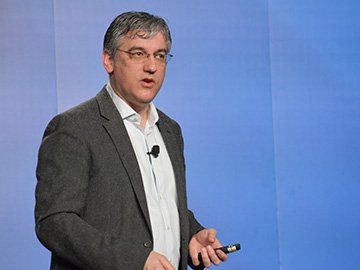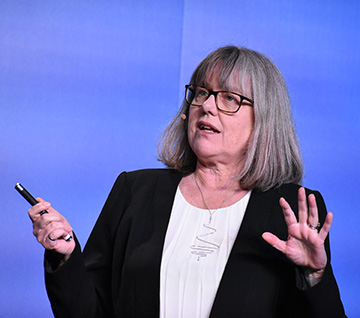The second plenary session of CLEO 2019 covered ground extending from the prospects for quantum computing to extreme states of matter—with lasers at the center of the action.
Christopher Monroe, a professor at the University of Maryland, USA, and a co-founder of the quantum computing start-up IonQ, talked about systems of laser-trapped ions as a potentially promising and scalable platform for quantum simulations and computing. And the 2018 Nobel Physics Laureates—OSA Fellow and Honorary Member Arthur Ashkin, OSA Fellow and 2013 President Donna Strickland, and OSA Fellow Gérard Mourou—provided insights into the technologies that they pioneered, and their potential.

Christopher Monroe at the CLEO Wednesday plenary session.
“Nature’s qubit”
Monroe opened the plenary talks with an argument for trapped-ion systems as a good bet for quantum computing. At one point in the talk he referred to atoms and ions as “nature’s qubits”—identical particles with atomic-clock precision that, he suggested, are the ideal platform for quantum computing. “The qubit part is done,” he said. “They’re much better than we need them to be.” The real challenge, he continued, lies “in the classical controllers” for those atomic quantum bits—“and that, in our technology, means optics.”
In talking about the motivations for quantum computing, Monroe noted that the high-performance-computing community is “running scared” at the moment, as traditional Moore’s law-style growth is “starting to saturate.” Quantum computing is one potential approach—along with some others, such as neuromorphic computing—that could allow continued growth. And it’s not a new idea. Monroe alluded to Richard Feynman’s celebrated “Plenty of room at the bottom” lecture in 1959, that suggested that circuits of individual atoms could provide “completely new opportunities for design”—opportunities, said Monroe, that we now understand to be quantum computing.
Strange opportunities
Monroe noted the “strange opportunities of quantum” that arise from phenomena such as superposition and entanglement, which he characterized as “having connections, or ‘wires’, without real wires.” These properties offer some good news—the state space can grow exponentially with the addition of qubits, in theory allowing systems to quickly scale to solve problems beyond the reach of classical computers.
But there’s also bad news, in that measuring the qubits is an inherently probabilistic exercise, and the more complex the input state, the dicier the result. Monroe said, however, that the theory of quantum interference, or quantum gates, codified by David Deutsch several decades ago, offers a way out. “I like to think of it,” Monroe said, “as a good news/bad news/good news story.”
As to what quantum computers would actually do, Monroe noted that the “killer app” that most people know is factoring large numbers. But factoring an “interesting” (that is, very large) number would require error-corrected quantum systems far larger than at present, something that, Monroe said, is “many years away.”
Other classes of problems that are more interesting, though, may be within closer reach; Monroe cited certain kinds of optimization problems (such as the celebrated traveling-salesman problem), physical simulations and other ideas. “We don’t yet have proofs that any of these kinds of problems can be exactly solved on a quantum computer,” according to Monroe, “but there are hints that quantum computers could be a heuristic that would give you a better answer than any classical approach could.”
Exotic hardware
Monroe noted that, as an “exotic form of computing,” quantum computing requires similarly exotic hardware to run. Two platforms in particular that he mentioned were superconducting circuits, such as those being pursued by some tech giants, and systems based on individual atoms, the domain of the IonQ startup that Monroe co-founded. “Industry is getting involved in this area in a big way, mostly with these two technologies,” according to Monroe.
Monroe said that atomic systems are “fundamentally scalable” in a way that “no solid-state system could ever dream of.” But controlling the atoms requires optical sources, and that “is 100 percent of the challenge in the technology I’m dealing with.” Nonetheless, IonQ, he suggested, has reached the point where it understands “the entire error budget” that arises from these issues, and has been able to move forward in a variety of problems regarding quantum simulation of dynamic phase transitions and other problems.
Scaling systems beyond 50 to 100 qubits may require the hardware to get even more exotic, Monroe noted—pointing to potential solutions such as a “multicore” architecture that would tie together individual quantum ion traps using photonic connections and an optical switch. “There’s lots of work that still needs to be done,” Monroe suggested, but he suggested that the company is making progress on integration on a variety of fronts.
Monroe ended his talk with a nod to the recently passed U.S. National Quantum Initiative as a mechanism for moving quantum engineering forward—noting in particular the important role of The Optical Society, SPIE, and the National Photonics Initiative in getting the initiative rapidly passed by the U.S. Congress. And he dangled future job prospects at IonQ, which currently has 35 employees, in front of any interested members of the audience. “We’ll probably triple in size over the next couple of years,” Monroe said. “And we expect to be hiring aggressively.”
Words from the 2018 Nobel Laureates
The other Wednesday plenary addresses turned to the recipients of the 2018 Nobel Prize in Physics, all of whom pioneered aspects of laser technology. Arthur Ashkin was unable to attend the conference, but OSA captured a video interview of him in his New Jersey home that was shown to the audience. In the video, Ashkin recalled the early experiments with optical tweezers decades ago. “The levitation and light-scattering experiments we did at that time were some of the most precise ever done,” he said, providing a description of some of the fundamental physics behind them. And he noted the generality of the technique and what it has enabled: “I assert, and I’ve demonstrated,” he said, “that you can trap essentially anything.”

Donna Strickland at the CLEO Wednesday plenary session.
The two other 2018 Nobel physics laureates—Donna Strickland and Gérard Mourou, who together invented the path-breaking technology of chirped-pulse amplification (CPA)—were both present at the conference, and each paid homage to the other. Strickland noted her feeling that Mourou should have come to the podium first, saying “Gérard leads and I follow.” And Mourou, for his part, noted that, as thrilling as it was to get the call from the Nobel Committee notifying him that he had received the prize, hearing that he would be sharing it with his former grad student Strickland was “the cherry on the cake … Thank you, Donna, for your nice work that took us to Stockholm.”
From HHG to CPA
In her talk, Strickland told the story of why she “was the one to do CPA, because [she] was the one studying high-intensity light-matter interactions.” While another Nobel Prize winner, Maria Goeppert Mayer, had pioneered the theory of two-photon absorption and nonlinear optics in the 1930s, the phenomenon wasn’t observed experimentally until 1961, when lasers made it possible to observe second-harmonic generation. The subsequent work of Stephen Harris suggested the possibility of even higher harmonic generation—and, at the suggestion her thesis advisor, Mourou, Strickland decided to attempt to get to ninth-order harmonic generation.
To do so, she needed “a really intense laser”—but, as Strickland described, self-focusing and nonlinear effects meant that very high intensity pulses could quickly damage the laser amplifiers of the time, leading to trains of damage spots on the laser rods. “I’ve seen many of these,” she said, “and it’s not pretty.”
What you want, Strickland said, is “a high-intensity pulse—a ‘laser hammer’ in a very short pulse. But you don’t want a hammer in your amplifier.” That led Mourou and Strickland to the notion of stretching the pulse, amplifying it and compressing it. Strickland described the process of leveraging the laser equipment of the time, including a frequency-doubled, 2-W Nd:YAG laser, optical fiber as the dispersive element to “chirp” the pulse in time, and paired gratings to re-compress the pulse after amplification.
The CPA road ahead

Gérard Mourou at the CLEO Wednesday plenary session.
Mourou, in his talk, spoke of his “passion for extreme light,” which arises in part from the vast application space that the invention of CPA has opened up. “What has really fascinated me,” he said, “is that you can do so much” with the laser, an invention first demonstrated by Ted Maiman in 1960. “You can slow down atoms to centimeters per second; you can also accelerate particles to near the speed of light … you can go from pico-eVs to tera-eVs, more than 20 orders of magnitude, all with 1-eV photons.”
While the energies involved in extreme light are trivial—“you had a thousand joules for your breakfast,” Mourou quipped—squeezing those energies into short pulses and 1-micron spot widths creates “enormous light pressures,” on the order of 1023 W/cm—the equivalent, said Mourou, of “10 million Eiffel towers on the tip of your finger.” This allows scientists to explore regimes of relativistic electron and proton acceleration, and even to go to the threshold of breaking down the vacuum itself. CPA is “the universal source of high-energy particles and radiation,” according to Mourou. “It opens incredible doors, the laser.”
Advancing machining, medicine and environment
Beyond exotic realms of new physics, Mourou noted other places where short-pulse lasers are have made a difference, and will continue to do so. These include things like micromachining and ophthalmology—“an area where you need very exquisite precision,” he said. (Some 24 million eye operations have been done with femtosecond lasers since 2001.)
The phenomenal intensities in the electron-acceleration regime have also opened up the field of plasma wakefield acceleration, which allows the production of electrons with energies of GeV/cm—previously the realm of synchrotron facilities stretching kilometers—in devices with a lab-scale footprint. Still other opportunities, Mourou pointed out, lie in areas such as proton therapy and neutron medicine, where CPA can lead to facilities that are more compact and safer; mitigating nuclear waste, by using CPA to transmute dangerous heavy radionuclides into lighter atoms with short half-lives; and even addressing the increasing societal problem of space debris.
A parting nod to Stockholm
Both Strickland and Mourou ended their talks with a few slides from last December’s Nobel Prize ceremony in Stockholm—with both scientists still, perhaps, a bit surprised by their journey to the ceremony’s opulent halls and their dinner engagements next to royalty. “I somehow went from being a grad student working on CPA, to being in a fairy tale,” Strickland said.
Mourou, meanwhile, recalled his emotion when, at the end of the week, he was asked for a signature. “At the end, they come with this notebook, with the signatures of all past Nobel Prizes—Steinbeck, Faulkner, Einstein, everybody,” Mourou said, recalling the day that he and Strickland added their names to the list. “It was a fantastic moment.”
